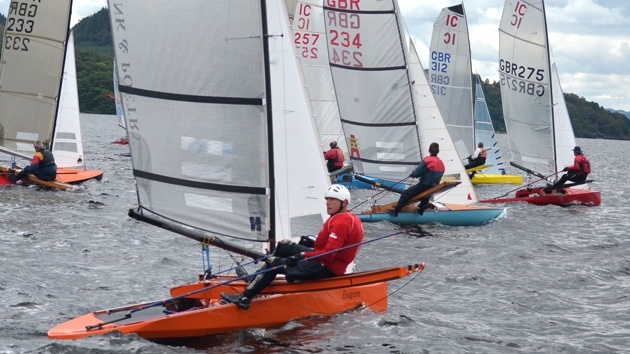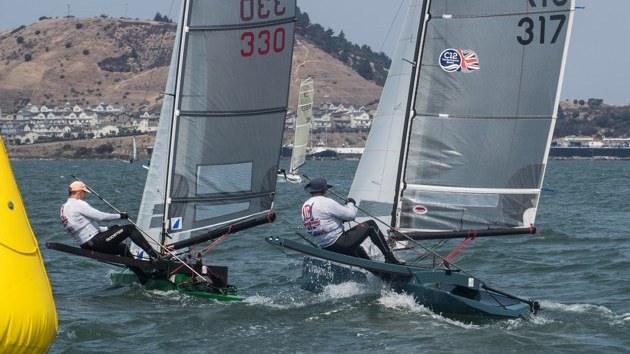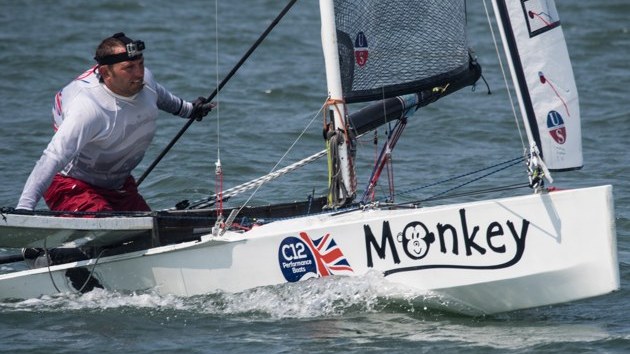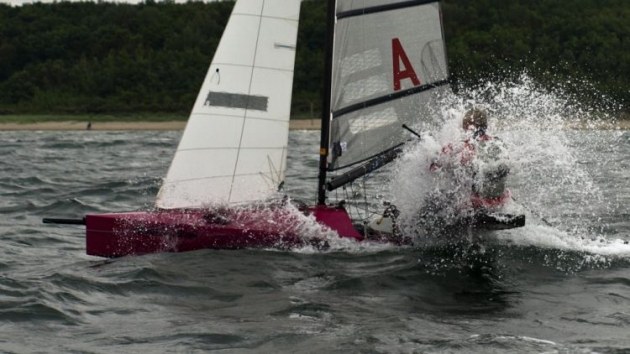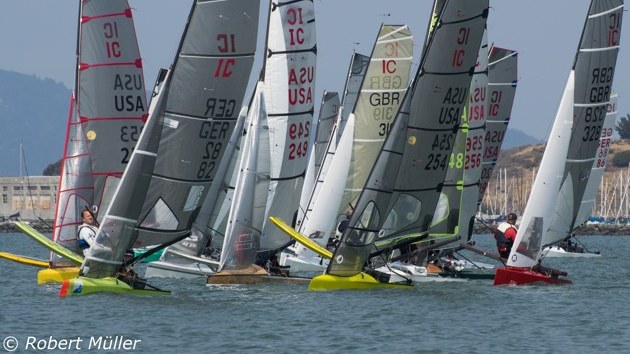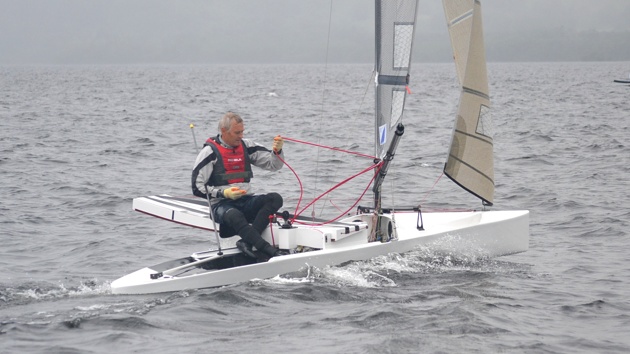1948 New York Canoe Club International Challenge Cup
In 1948 Lou Whitman and Adolph Morse of the Phoenix Canoe Club challenged for the New York Canoe Club Cup.
The Royal Canoe Club fleet assembled at Hayling Island at the end of July to select a defender for the international races. Harris St.John, Joe Lubbock and 'Bee' MacKinnon were the three top helms of the series. Harris St. John and MacKinnon were chosen as being more experienced than Joe Lubbock at canoe sailing, although Joe Lubbock came second in the series. Joe Lubbock lent 'Bee' MacKinnon his new canoe Storm Petrel for the races. Of the three races, 'Storm Petrel' won two, which were both light weather races.
"The races for the New York Canoe Club Cup introduced me to a new form of team racing, quite unlike that which is usually met in this country. We usually score one point for each boat beaten, and sometimes an additional quarter point for a win. The result is that even the last two boats, if they are on opposite sides, are racing against each other right up to the finish, and their order of finishing may affect the final result. Although this cup was raced for this year on our waters (in Chichester Harbour) the rules provide for their system of scoring to be used. The system is simply that the first boat home scores one and the rest nothing, and the match is on the result of three races. It might be thought that this would give less opportunity for team-work, but after taking part in the races I am all for this system, especially with two boats a side, and even with three a side I think it would still be more interesting than the usual system.
"The problem as it faced me and my team mate before the cup races was this: we had two boats which we knew were approximately equal in speed, and all we could guess of our two opponents was that one was probably the better of the two in light winds and the other in strong winds; how to arrange our tactics to give us the best chance of first boat home? The obvious plan, calling our boats A and B and our opponents X and, Y, was for A to keep ahead of X and B to keep ahead of Y. But we decided that this was not the best possible plan, and that something more flexible and at the same time more ambitious was required. The one we eventually adopted was this: that each of us would start off with the object of finishing first, and as soon as one was appreciably ahead of the other he would continue to sail what appeared to him the quickest way to the finish, regardless of what his team mate or our two opponents did. Our second boat would then begin either to cover the more dangerous looking of our two opponents or to try to pass him as the case might be. The idea behind this plan was that there are always several ways of sailing the course, especially on the windward leg, and the differences between these were likely to be greater than those between the speed of the boats or the skill of the helmsmen. We should therefore have two attempts (one each) at choosing the fastest course, and whichever of us chose less well would then start insuring against either of his opponents having chosen better than his mate. We thought this plan gave us a better chance of using both our boats against one threatening opponent. In certain circumstances it would lead to the same result as the plan by which A covers X and B covers Y; but the latter is open to the danger that if A is ahead and X second A may be led astray in covering X, and B may then fail to beat Y. Our reasoning in this position was that A has a good chance of winning if he disregards X, while B may be able to beat him even if A fails. In the event of three races there was little team-work except in the last one, and I am hoping for further opportunities of trying out this scoring system. I am inclined to think that in any race of two boats a side it will add to, rather than detract from the interest.
"The course for the cup races was a triangle about 10 miles round. The start of each race was at the leeward end of the upwind leg and the course consisted of three rounds of the triangle plus one leg, so that the race started and finished with a full windward leg. This seemed an improvement on the Olympic courses where the initial and final beats were too short. Perhaps a further improvement on our course would be to omit one mark on the second round, as on the Olympic course, so giving a run instead of the two reaches. But there is less need for this in canoes than in classes which carry spinnakers and for us the course as sailed was ideal.
"The challengers were 'Nymph II' sailed by Adolph Morse and 'Manana II' sailed by Lou Whitman, while the defenders were 'Storm Petrel' sailed by me and 'Flying Fish' sailed by Charles St. John. 'Nymph II' was the unsuccessful challenger of I936 but entirely rerigged and redecked and a greatly improved boat. 'Manana II' was a new boat built last winter by her owner. 'Storm Petrel' and 'Flying Fish' were very much alike, built by Uffa Fox in 1946 and 1938 respectively, and we knew that in all but the strongest winds both were greatly superior to the successful defender of 1936. Until after the match this was all we knew about the relative form of the four boats, but there was a striking difference in the method of sailing them. The rules permit a sliding seat extending not more than five feet outside the gunwale; the Americans make fast their sheets and go out along the seat as far as necessary, using a thwartships tiller, while we use a normal tiller and extensions and in strong winds sit with our feet on the gunwale and play the main sheet. Both methods have their disadvantages that of theirs is that if the wind blows too hard it is impossible to free the mainsheet, while we do not make full use of the length of seat allowed. One result of the match will no doubt be the development of a successful combination of the two. For the first race the wind was S.W. about 15 knots and the start at the East Mark about three quarters of an hour before high water. It was clear that, so long as the flood tide continued, it was advantageous to make a long port tack soon after the start, thus keeping to the northward of the main Chichester Channel in which the tide would be stronger. The line was so laid that it was slightly advantageous to start at the south end. With only two opponents there seemed a chance of getting a start on the port tack at this end, and I was encouraged in this by seeing 'Nymph' , shortly before the start, obviously too far away to get back anywhere near the gun. A few seconds before the gun, while approaching the line on the port tack, I looked under my boom and saw 'Manana' reaching along the line on the starboard tack and got a very clear impression that I should cross him even if he hauled his wind; so I got out on the sliding seat and concentrated on sailing the boat. To my dismay, immediately after the gun I heard a cry of " starboard," and 'Manana�s' bow appeared about three feet from my stern. I sailed on, wondering what had happened and what I ought to do. There was no question of retiring, as I had no means of knowing whether he had, in fact, borne away to clear me or had shouted merely because he thought I was cutting it too fine. He by this time was 30 yards away on my weather quarter, and in that amount of wind shouting at another boat is apt to lead to misunderstanding, so I sailed on, but decided that I should have to consult both Lou and the Committee (who must have seen it all) after the race. As things turned out, there was no inquest on this incident, so I never knew exactly what did happen. Obviously, my start involved a risk of protest, which was not justifiable in a match of three races only, and I determined to be more careful in future.
"But the point emerges that on the "first boat home" system of scoring, if you get yourself disqualified, it is still possible for your partner to win the race, and a slight risk can therefore be taken. On our system, the penalty in points is, so severe that no risk at all is justified, and this, to my mind, is a point in favour of the American system, for in normal racing one must cut things fine to be successful, with an occasional misjudgement as the result, just as a good starter must expect to be over the line occasionally. In this race I soon had something else to think about, because 'Manana' , having tacked on my weather quarter, sailed straight past me to windward, and within five minutes had pulled up to a position four or five lengths dead to windward of me. We were both sailing fairly free, and even by easing my sheets slightly I could not keep up with him, though I managed to keep my wind free for a time. Before long I had to acknowledge that there was nothing I could do about it, and that 'Manana' simply went faster through the water on the same course as me. I looked under the hull for seaweed on the plate or rudder, but there was none, and I began to see the cup going back to America after two races only. 'Flying Fish' was close behind me, but not able to keep up with 'Manana' any better than I was. The race continued a procession until the third round, by which time the tide had begun to ebb, and it was obvious to local knowledge that the best course on the windward leg was to stand south on starboard, across the Chichester Channel ebb, and then tack over the Winner, following the course EBS in Fig. 2 instead of EAS as on the first two rounds.' Manana' rounded the East Mark nearly a minute and a half ahead and went off on the port tack. I went to the southward on starboard. According to our plan, it was right for 'Flying Fish' to follow' Manana' ; he might have been right, and there was a faint chance that 'Flying Fish' might catch him, though his lead appeared to be too big for any plan to have any hope. As it turned out, the southward course was so much superior that I reached the weather mark just ahead of 'Manana' . It is quite likely that the plan contributed to this, although I admit the situation was not one we had foreseen. But Lou, looking back, would probably have covered us if we had both gone to the southward, and in that case neither of us would have caught him. My triumph was short lived, for 'Manana' was still the faster boat in that strength of wind, and he passed me on the second of the two reaching legs; and naturally he did not again make the mistake of letting me go off by myself.
"For the second race the course and wind direction were the same, but the wind strength considerably less; about 8 knots. This time 'Manana' was on the port tack and to leeward at the start, and 'Nymph' farther to leeward still, so I was able to start in the same place as the day before but perfectly safely. 'Flying Fish' was close on my weather quarter. I only had to watch 'Manana' in case she should tack on to starboard and gather way before I could cross her. We both sailed free for the first five minutes, at the end of which it was obvious that the lighter wind had turned the tables and 'Storm Petrel' was gaining rapidly on 'Manana. Flying Fish' was sailing rather higher on the wind and holding me, and therefore also gaining on Manana. 'Nymph' was nowhere, and the rest of the race was a procession. We afterwards realised as the result of these and other races that 'Nymph' was dangerous to us in very light airs and 'Manana' in heavy weather, while in this strength of wind our boats were superior. All we knew at the moment was that we were first and second, and according to plan I took no notice of anybody while 'Flying Fish' kept an eye on them whenever either diverged from my course. We finished first and second with some ease; had 'Flying Fish' had the better start the plan would, of course, have reversed our roles, and she would probably have been first.
"On the day of the third race, half an hour before the start was due, there was no wind at all. The Committee quite rightly postponed the start half an hour and said that at the end of that time they would either start us or postpone for a day (the start could not be much later because the triangular course would begin to dry out at half ebb). Well before the postponed start, a light southerly wind came, and the course was set to start at the North Mark. When we reached the starting line, the wind was still so light that I was careful not to get to leeward of the line, as the flood tide was running northwards and till fairly strong. But a slight increase of wind before the start made things easier, and during the race it freshened to about 5 knots. The windward leg was interesting in the choices it offered. The First mark was to windward and the direct course to it lay diagonally across the Emsworth Channel in which an appreciable foul tide was running. It was obvious that the quickest way there was to make a long port tack to the shallow water on the west side of this channel, and there make short tacks in the slack water but whether to make a few tacks on the east side of the channel first was by no means clear. The east end of the starting line was slightly to windward, but if one was going across the channel at once, the other end was of course, nearer the slack water which one wanted to reach. It seemed to me best to start at the east end, but then to cross over at once. As the start approached I found that 'Nymph' was of the same idea, while 'Manana' and 'Flying Fish' were manoeuvring at the west end of the line.
"A few seconds before the start 'Nymph' was outside the distance mark and reaching away from the line with me directly astern of him so that he could not tack. When I felt sure we were not early I tacked and led him back to the line, crossing slightly late but in a commanding position. Meanwhile 'Flying Fish' had crossed the lee end of the line also on the port tack and ahead of 'Manana' . So for the moment we were each in the position of covering one opponent. Three or four minutes later I found myself 50 yards ahead of 'Nymph' but about 20 yards to leeward of his course, he having sailed high to clear my backwind. We were well ahead of the other two, and according to the plan I should have carried on, but the wind was shifty and if it freed on us it would have brought him level with me, so I played for safety by tacking on to starboard and back again to port after I had crossed his bow. Probably I threw away four lengths by these two tacks, and in steady wind they would have been quite unnecessary, as I should have felt perfectly safe well ahead and slightly to leeward, but the shiftiness of the wind seemed to me at the time to justify them. On reaching the west side of the Emsworth Channel I was too cautious about going into the shallow water, but 'Flying Fish' quite rightly went right in to keep ahead of 'Manana' . The only result of this was that she reached the mark first whereas 'Manana' , not at her best in the light conditions, failed to pass me or even 'Nymph' . The order remained unchanged on the two reaches, and so we came to the North Mark again with 'Flying Fish' first, myself second and 'Nymph' third.
According to the plan 'Flying Fish' set off on the port tack to the slack water, while I held on the same tack until I saw what 'Nymph ' was going to do. She tacked to starboard soon after the mark, probably thinking it was a waste of time following in the wake of both of us, so I followed suit. After three or four minutes she tacked back to port tack, and naturally I did the same. 'Manana' meanwhile had followed 'Flying Fish' and both had sailed into the shallow water tacked, and were coming out again on the starboard tack. The four boats converged, and momentarily we were all on the same upwind line, in the order 'Flying Fish' on starboard, myself on port, 'Nymph' on port, 'Manana' on starboard (Fig. 4 position 3). At this moment both our opponents tacked. I was supposed to be covering 'Nymph' , and would normally have tacked when she did, but to do so would have put me exactly in 'Flying Fish' �s wind shadow which seemed stupid, so I carried on for the moment. 'Flying Fish' now found herself unexpectedly in the position of cutting the wind off 'Nymph' , who was clearly in that weather the more dangerous opponent, so she also carried on. This was not strictly in accordance with the plan, but was a brilliant piece of opportunism, seizing chance which no plan could have provided for. Seeing this happening, there still seemed no point in my tacking dual with a boat which was already being looked after, so I remained on port. The result was that I reached the slack water while 'Nymph' and 'Flying Fish' were still out in the tide, and I found when we met again at the mark that I was now leading with 'Flying Fish' second. There was no further change in the order for a round and a half. Then, on the last reach from East to North Marks, 'Nymph' crept up on 'Flying Fish' and began to pass her to windward. This was a golden opportunity for 'Flying Fish' to defend the lead which she had given me at an earlier stage, and of course she luffed 'Nymph' until both were well to windward of the straight course and faced with a dead run to the North Mark against the tide, which by now was ebbing.
'Manana' held a straight course from the East Mark to the North and consequently sailed through the lee of the other two and reached the mark second, but he was much too far behind to have any hope of catching me on the last beat with a fair tide. But I was profoundly thankful to see Nymph set back by 'Flying Fish's' luffing to an even safer distance behind me. She passed' Flying Fish' on the run to the North mark, but of course on this system of scoring, the result was not affected. I am glad to say that all the spectators realised that 'Flying Fish' was last as the result of correct team tactics which had made things safe for me.
From Andrew Eastwood's History of Canoe Sailing in Britain.
